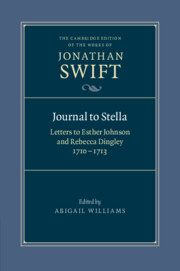Book contents
- Frontmatter
- Contents
- List of Illustrations Page
- General Editors’ Preface
- Acknowledgements
- Chronology
- List of Abbreviations
- Introduction
- Calendar of Letters
- Letters to Esther Johnson and Rebecca Dingley, 1710–1713
- Appendices
- A Swift, Harley, St John and the Political Debates Behind the Journal to Stella
- B Surviving Letters to and From Esther Johnson and Rebecca Dingley
- C Letter 2 in Print and Manuscript
- D Facsimile of Letter From Esther Johnson and Rebecca Dingley to Robert Dingley
- E Glossary of Little Language Used in the Journal to Stella
- F Biographical Appendix
- Textual Account
- Bibliography
- Index
Introduction
Published online by Cambridge University Press: 02 September 2021
- Frontmatter
- Contents
- List of Illustrations Page
- General Editors’ Preface
- Acknowledgements
- Chronology
- List of Abbreviations
- Introduction
- Calendar of Letters
- Letters to Esther Johnson and Rebecca Dingley, 1710–1713
- Appendices
- A Swift, Harley, St John and the Political Debates Behind the Journal to Stella
- B Surviving Letters to and From Esther Johnson and Rebecca Dingley
- C Letter 2 in Print and Manuscript
- D Facsimile of Letter From Esther Johnson and Rebecca Dingley to Robert Dingley
- E Glossary of Little Language Used in the Journal to Stella
- F Biographical Appendix
- Textual Account
- Bibliography
- Index
Summary
When Jonathan Swift began writing the work now known as the Journal to Stella on 2 September 1710, he was a man on the edge of public life: he was vicar of Laracor and canon of St Patrick’s, the author of Contests and Dissensions and the unacknowledged author of Tale of a Tub. He had some experience of negotiating with the Whig ministry, but had little practical or formal role in London political life. By the time he had completed the Journal to Stella, the set of letter-diaries written between 1710 and 1713 to his two close friends Esther Johnson and Rebecca Dingley, he had been chief propagandist for the Tory ministry, member of the Brothers’ club, and both mocked and respected as a court insider. The series of letters recounts his experiences during the three most politically active and exciting years of his career in a sequence of familiar and apparently unguarded accounts. The letters themselves are a curious blend of high political narrative, personal memoir, business transaction and flirtatious exchange. They were not given the posthumous title of ‘Journal to Stella’ until sixty years after their initial composition.
The surviving letters are also, of course, only one side of a correspondence. No letters at all from the Journal period from either Johnson or Dingley to Swift survive, and only one letter, from Dingley to Swift, survives outside of the series. Although we have a record of Swift's receipt of his letters from ‘MD’, or ‘the ladies’, as Swift routinely referred to his correspondents, we can only infer the contents of the replies from Swift's own. We also know very little about the biography of either Esther Johnson or Rebecca Dingley beyond what Swift himself wrote in the short biographical sketch that he began on the night of Johnson's death in 1728. In this account, he states that he met Esther Johnson in the spring of 1689, when she was eight and he was twenty-one, at the time that he entered the household of Sir William Temple. Esther's mother, Bridget Johnson, was in the service of Martha, Lady Giffard, sister of Sir William. Rebecca Dingley, then aged around twenty-three, was a dependent relation of Sir William Temple, and the two women had become friendly at Temple's house in Moor Park.
- Type
- Chapter
- Information
- Journal to StellaLetters to Esther Johnson and Rebecca Dingley, 1710–1713, pp. xxxi - lxxxviiPublisher: Cambridge University PressPrint publication year: 2013



